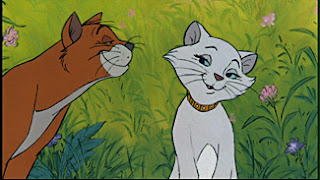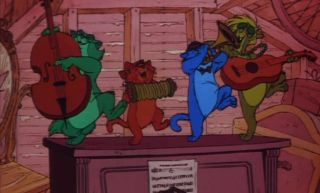Twenty films in, it is striking how different the first dozen and a half Disney features are from one another. Yes, the package films share a format, the princess stories contain many of the same tropes, and all of the features possess the same underlying aesthetic, but it is quite easy to parse out the myriad differences between say, Dumbo and The Jungle Book, or The Sword in the Stone and Alice in Wonderland. Perhaps the knowledge of Walt's passing unfairly taints one's judgment, but 1970's The Aristocats feels by far the most derivative and familiar. More than any other film up to this point, The Aristocats bears a overwhelming similarity with a previous Disney feature. Well, make that two features; Lady and the Tramp and One Hundred and One Dalmatians.
It is difficult to determine which of the two previous features The Aristocats more closely resembles. The high life of Duchess and her kittens showcased in the opening scenes, the budding romance between her and the freewheeling alley cat Thomas O'Malley, and the appearance of a dimwitted bloodhound who recalls the faithful Trusty, all produce enormous echoes of Lady and the Tramp. Meanwhile One Hundred and One Dalmatians is faithfully evoked in the sketchy animation style, while the arduous journey the cats undertake to get back to Paris after being abandoned in the countryside is almost an identical story element to the latter film.
And yet The Aristocats manages to transcend its comparisons and come out a rather worthwhile and ultimately fun picture. I for one would put it above Dalmatians in the triptych rankings, although both are far below the majesty and emotional elegance of Lady and the Tramp, which is a truly enduring work of art. The Aristocats possesses a much better rhythm than Dalmatians, which gave no clear indication of the length of the puppies' journey back home. Everything flows much more smoothly with the cats, the film rarely hits a dull patch. The climax that sees the alley cats coming to save Duchess and her brood, is a ramshackle spectacle of fast-paced action that never once feels rushed. A lot of Disney films in fact suffer from split-second third acts wherein the villain is vanquished in a matter of moments, followed by an all too brief coda. The Aristocats does not quite linger, but it also doesn't speed.
One of the film's weaknesses however is the animation style, which is so threadbare -- particularly in early moments with the human characters -- that it often becomes distracting. The animation of the cats' guardian, Madame Adelaide, is the biggest offender. Her white hair shows numerous pencil lines whenever she tilts her head and her physical movement is jerky and entirely unnatural. The design and action of the cats themselves is decidedly better, although the film never once reaches the heights of previous Disney features like Bambi or even Dalmatians for that matter. Occasionally elegant moments will pop out, but they are fleeting. For example, early on in the film when Thomas O'Malley is hitting on Duchess, he keeps on smooth-talking while subconsciously rolling over onto his back and stretching, in a perfectly executed moment of feline physics. Much later on he hooks his tail beneath Duchess's as a means of holding hands in a piece of animation both subtle and graceful.
Thomas O'Malley is voiced by Phil Harris, who did such a wonderful job as the scene-stealing Baloo in The Jungle Book that he was tasked here with playing roughly the same exact character. A few other stock Disney voices make an appearance as well, alongside new talent including Eva Gabor as the prim and proper Duchess. Of course, the ubiquitous Sterling Holloway makes an appearance. Here he plays Roquefort, a household mouse who is good friends with the cats. The best appearance of a Disney regular here though comes courtesy of the wonderfully-named Thurl Ravenscroft who briefly crops up as the bass-playing Billy Boss, a Russian cat with a huge beard that is a bandmember of the alley cat gang, led by Scat Cat, himself fabulously portrayed by Scatman Cruthers. (Ravenscroft will forever be remembered as a different cartoon cat as he spent fifty years providing the voice of breakfast cereal mascot Tony the Tiger.)
The alley cat band performs a raucous rendition (only slightly marred by an egregiously offensive racist stereotype) of "Ev'rybody Wants to Be a Cat", one of four fantastic songs written for the film by the Sherman Brothers. Here the brothers are once again in fine form, this time showcasing their incredible versatility. The swinging jazz rumpus of "Ev'rybody..." is juxtaposed early on with the sweet and deceptively simple "Scales and Arpeggios" that takes music theory as its inspiration. Thomas O'Malley gets a jaunty theme song that spells out his disposition and philosophy, much like "Bare Necessities" did in The Jungle Book. The smooth title number features the last recording of the elegant crooner Maurice Chevalier, who came out of retirement specifically for the film. He was convinced to take the job by a demo recording of the song sung by Richard Sherman in full Chevalier imitation. Excluding previously written work that would appear in the package film The Many Adventures of Winnie the Pooh, The Aristocats would be the last animated Disney feature the Sherman brothers would work on until The Tigger Movie in 2000.
All in all, The Aristocats performs rather admirably despite its various setbacks. The film was made at a time of great uncertainty at the studio. The budget was minuscule and production resources were at a minimum. The film's place in the Disney lineage means it will always be compared to the many classics that preceded it. And yet The Aristocats has a well-defined sense of purpose and a surprising amount of confidence. The film doesn't take chances but it doesn't necessarily need to. It proves its worth in its devotion to the characters, who really care about one another. They convince us that this story is worth telling and it's their personalities that make the journey a worthwhile one, every paw print of the way.







































